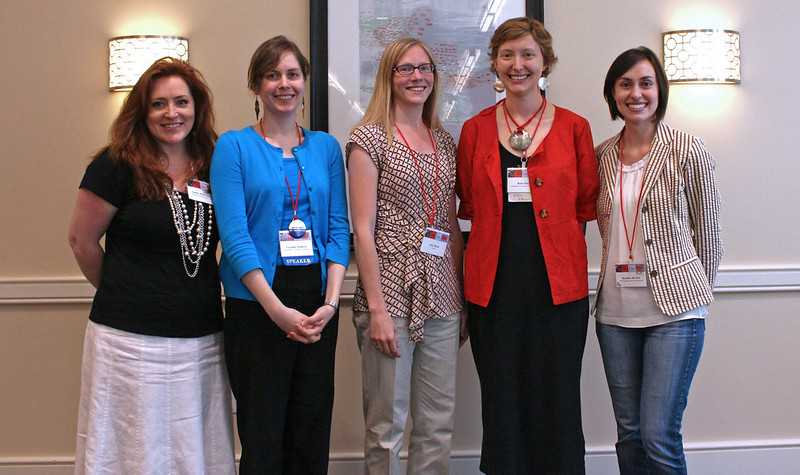Do conservators in different specialities think differently? Do they form different perceptions, goals and objectives based on their material specialization? Textiles are often one component of a composite object and how might treatment approach differ when being decided by an object or painting conservator rather than a textile conservator? These were the questions posed for this panel discussion. The moderator, Kathy Francis, (Francis Textile Conservation, NJ) introduced the panel topic with an object treatment she had encountered: a French chef automaton by Gustave Vichy. Rather than conserve the worn suit of clothing, a reproduction set of clothing was made. The treatment emphasized the object’s value as a performance piece that moved and performed and thus favored the object’s primary material with consequence for the textile material (replaced). Kathy also referred the audience to a paper on factors that influence textile treatment decisions and, particularly, the role connoisseurship bias can play in treatment choices: The Role of Connoisseurship in Determining the Textile Conservator’s Treatment Options by Patsy Orlosfsky and Deborah Lee Trupin, published in the JAIC in 1993. Kathy’s introduction to the topic was followed by presentations from the three panelists:
Stephanie Hornbeck (Caryatid Conservation) drew from her experience treating composite objects at the National Museum of African Art, where she worked for twelve years. She described it as working at the nexus of ethnographic objects and textiles where collaboration was common. Often, work was undertaken after consulting specialists on the various materials composing the object. Furthermore, in this type of collection, wear, evidence of use and native repairs can be of greater influence on treatment.
Nancy Pollak (Paintings Conservator, Art Care Associates) discussed paintings on canvas versus painted textiles. In the case of a painting, the canvas is the support. It is referred to as a canvas rather than a textile. In the case of a painted textile such as a banner, for example, the textile is viewed as more of an integral component of the aesthetic value or design. Nancy concluded by suggesting that the conservator evaluate an object by questioning which material is in the role of master and which in the role of servant. In the case of a traditional painting, servant is to master as canvas is to painting but when considering a trade banner, this relationship becomes harder to define.
Nancie Ravenel (Conservator, Shelburne Museum) discussed managing conservation and preservation of a large collection without a textile conservator on permanent staff. She relies on a combination of IMLS grant funded conservation surveys by textile conservators, dedicated volunteers to carry out basic textile conservation work, contract textile conservators and collaboration with textile conservators as guidance for complex treatments. She presented the treatment of pieces from a Tiffany-designed suite of upholstered furniture as an example of collaborative treatment with upholstery conservator Nancy Britton consulting.
It would have been nice to have more discussion time afterward as there were many questions and comments. A contemporary paintings conservator whose work often emphasized restoring work to a pristine condition, asked the panel how they arrived at their aesthetic and responses included: “Its fluid”, “It depends”, “subjective”, “case by case”, “determined by aesthetic of the curator”.
An art historian commented that replicas for display purposes should be used more often to resolve conservation issues and that museum visitors didn’t care about original material anyway, that was of interest only to scholars. Many in the audience, myself included, were wary of this suggestion. I think I mostly take issue with the suggestion that museum visitors don’t care if they are viewing a replica. There are, of course, appropriate uses of replicas in place of the original material, or displayed alongside original material to aid understanding of the object’s function- as another commented: “Seeing a flag fly”. The art historian was perhaps referring to contemporary art and installation art where the wishes of the creator are still known and the ideas conveyed have more significance or value than the media or material. In contrast, history collections or ethnographic/material culture collections often place significance on evidence of use, wear and repairs and the original material has cultural value. Another commented that in museums, objects have been removed from their original context anyway. As mentioned earlier, the JAIC article by Orlofsky and Trupin, offers multiple examples of the role, or current context, of the object influencing the conservation process. A fine art museum might value the aesthetics of an object while an history museum might value the same object for its cultural significance or original use.
Someone questioned whether the objects conservator was unique to North America as she hadn’t really encountered the term before. Nancie Ravenel confirmed the definition of objects conservator as a general specialist and emphasized that she is continually learning by taking workshops and through communication and collaboration with colleagues. The generosity of colleagues in sharing their expertise with each other was a recurring theme in the TSG sessions.
To summarize, the panelist presentations and the discussion afterward suggest that yes, conservators in different specializations do think differently and probably also think differently depending on the role, or context, ascribed to the object by a museum, curator or collector. The variety of factors that influence conservation treatment decisions really do call for a case by case approach. Often, collaboration and consultation between conservators from different specializations guides development of informed treatment goals and objectives.





